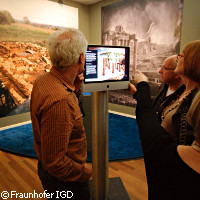When culture meets science
How many times have you asked yourself what it would have been like to live in the ancient world, to walk among and live in buildings that only grace the pages of our history books? State-of-the-art technology developed by the Fraunhofer Institute for Computer Graphics Research (IGD) in Germany gives us the chance to imagine just what it was like. The researchers' digital technology enhances real images on a virtual tour through ancient buildings. The end result is a dramatic tour experience for museum visitors. The Fraunhofer IGD team applied the digital technology at a recent exhibition in the Allard Pierson Museum in Amsterdam, the Netherlands. Visitors could stroll through sites that have found a niche in history. A flat screen on a rotating column was positioned amongst many art works showing an extract of the image on the wall, a black and white photo of the Roman Forum ruins. When the column is rotated to the left, the viewer is given a completely different angle. The researchers said the camera connected to the back of the movable display gives information about the new view that is shown on the monitor: the Temple of Saturn ruins. They added that a digital animation gives viewers an idea of what the temple might have looked like when intact. Further rotation of the column offers new information, photos and videos about other ancient buildings such as the Colosseum. 'We have taught the computer to recognise the image,' explained Michael Zöllner, a designer at Fraunhofer IGD. 'The program knows where the centre of the camera is pointing and can superimpose the relevant overlay - a text, video or animation.' The team said visitors to the museum are always aware of where they are on the tour because the original image is clearly shown under the overlays at all times. Experts call this technology 'augmented reality': unlike virtual reality which creates computer-generated environments, this technology enhances what we feel, see, hear and smell. The software developed by Fraunhofer IGD and used in the museum operates on a mini-computer and is controlled via a touch screen. Experts believe this console is just the start of a trend towards mobile and virtual guidebooks. For example, tourists will use their consoles in front of a palace, and customised information regarding the palace will pop up on the screen. The Fraunhofer IGD team has also tested this 'vision' in the EU-funded ITACITUS ('Intelligent tourism and cultural information through ubiquitous services') project, where Mr Zöllner and his team programmed a portable computer to act as an electronic tourist guide for the Royal Palace of Venaria in Italy. The researchers said the new mobile phone technology could play a pivotal role in fuelling people's interest for this feature. 'The smart phone means that augmented reality is at last suitable for the mass market,' Mr Zöllner said. ITACITUS received EUR 1.35 million under the 'Information society technologies' (IST) Thematic area of the EU's Sixth Framework Programme (FP6). Launched in 2006 and completed in 2009, ITACITUS brought together researchers and industry actors from Greece, Germany, Italy and the UK. The project partners investigated novel methods of representing cultural heritage virtually and facilitated the customisation of personalised walking and public transport tours in archaeological sites, museums and urban areas.
Countries
Germany



